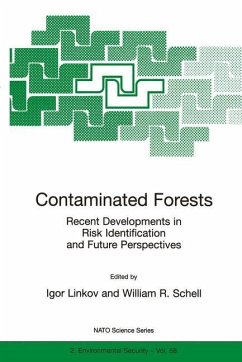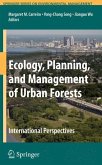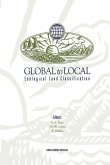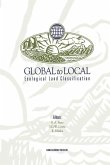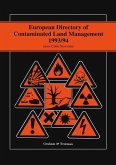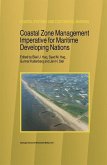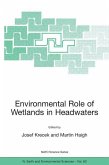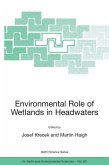Igor Linkov / William R. Schell (Hgg.)Recent Developments in Risk Identification and Future Perspectives
Contaminated Forests
Recent Developments in Risk Identification and Future Perspectives
Herausgeber: Linkov, Igor, Schell, William R.
Igor Linkov / William R. Schell (Hgg.)Recent Developments in Risk Identification and Future Perspectives
Contaminated Forests
Recent Developments in Risk Identification and Future Perspectives
Herausgeber: Linkov, Igor, Schell, William R.
- Broschiertes Buch
- Merkliste
- Auf die Merkliste
- Bewerten Bewerten
- Teilen
- Produkt teilen
- Produkterinnerung
- Produkterinnerung
Concentrations of pollutants in the atmosphere have increased dramatically over the last century and many of these changes are attributable to anthropogenic activities. The influence of acid rain has been well studied, but there has been no extensive exploration of other pollutants, such as toxic chemicals, heavy metals and radionuclides. Natural ecosystems, especially forests, tend to accumulate many of these pollutants which subsequently can affect ecosystem health. These contaminants may be very damaging to the environment in Eastern Europe, where the rapid disappearance of forest is the…mehr
Andere Kunden interessierten sich auch für
![Ecology, Planning, and Management of Urban Forests Ecology, Planning, and Management of Urban Forests]() Margaret M. Carreiro / Yong-Chang Song / Jianguo Wu (eds.)Ecology, Planning, and Management of Urban Forests113,99 €
Margaret M. Carreiro / Yong-Chang Song / Jianguo Wu (eds.)Ecology, Planning, and Management of Urban Forests113,99 €![Global to Local: Ecological Land Classification Global to Local: Ecological Land Classification]() Global to Local: Ecological Land Classification153,99 €
Global to Local: Ecological Land Classification153,99 €![Global to Local: Ecological Land Classification Global to Local: Ecological Land Classification]() Richard A. Sims / Ian G.W. Corns / Karel Klinka (Hgg.)Global to Local: Ecological Land Classification154,99 €
Richard A. Sims / Ian G.W. Corns / Karel Klinka (Hgg.)Global to Local: Ecological Land Classification154,99 €![European Directory of Contaminated Land Management 1993/94 European Directory of Contaminated Land Management 1993/94]() Colin Newsome (Hrsg.)European Directory of Contaminated Land Management 1993/94229,99 €
Colin Newsome (Hrsg.)European Directory of Contaminated Land Management 1993/94229,99 €![Coastal Zone Management Imperative for Maritime Developing Nations Coastal Zone Management Imperative for Maritime Developing Nations]() B.U. Haq (ed.) / Gunnar Kullenberg / Jan H. StelCoastal Zone Management Imperative for Maritime Developing Nations168,99 €
B.U. Haq (ed.) / Gunnar Kullenberg / Jan H. StelCoastal Zone Management Imperative for Maritime Developing Nations168,99 €![Environmental Role of Wetlands in Headwaters Environmental Role of Wetlands in Headwaters]() Josef Krecek / Martin Haigh (eds.)Environmental Role of Wetlands in Headwaters211,99 €
Josef Krecek / Martin Haigh (eds.)Environmental Role of Wetlands in Headwaters211,99 €![Environmental Role of Wetlands in Headwaters Environmental Role of Wetlands in Headwaters]() Josef Krecek / Martin Haigh (eds.)Environmental Role of Wetlands in Headwaters211,99 €
Josef Krecek / Martin Haigh (eds.)Environmental Role of Wetlands in Headwaters211,99 €-
-
-
Concentrations of pollutants in the atmosphere have increased dramatically over the last century and many of these changes are attributable to anthropogenic activities. The influence of acid rain has been well studied, but there has been no extensive exploration of other pollutants, such as toxic chemicals, heavy metals and radionuclides. Natural ecosystems, especially forests, tend to accumulate many of these pollutants which subsequently can affect ecosystem health. These contaminants may be very damaging to the environment in Eastern Europe, where the rapid disappearance of forest is the result not only of contamination but also of poor forest management practices.
The current book is designed to reduce the uncertainty in our current knowledge of forest radioecology. The three topics it embraces are (a) Modelling, (b) Measurements and Data, and (c) Countermeasures and Risk Assessment.
The current book is designed to reduce the uncertainty in our current knowledge of forest radioecology. The three topics it embraces are (a) Modelling, (b) Measurements and Data, and (c) Countermeasures and Risk Assessment.
Produktdetails
- Produktdetails
- Nato Science Partnership Subseries: 2 58
- Verlag: Springer / Springer Netherlands
- Artikelnr. des Verlages: 978-0-7923-5739-1
- 1999.
- Seitenzahl: 448
- Erscheinungstermin: 30. April 1999
- Englisch
- Abmessung: 240mm x 160mm x 25mm
- Gewicht: 626g
- ISBN-13: 9780792357391
- ISBN-10: 0792357396
- Artikelnr.: 23079573
- Herstellerkennzeichnung
- Springer-Verlag GmbH
- Tiergartenstr. 17
- 69121 Heidelberg
- ProductSafety@springernature.com
- Nato Science Partnership Subseries: 2 58
- Verlag: Springer / Springer Netherlands
- Artikelnr. des Verlages: 978-0-7923-5739-1
- 1999.
- Seitenzahl: 448
- Erscheinungstermin: 30. April 1999
- Englisch
- Abmessung: 240mm x 160mm x 25mm
- Gewicht: 626g
- ISBN-13: 9780792357391
- ISBN-10: 0792357396
- Artikelnr.: 23079573
- Herstellerkennzeichnung
- Springer-Verlag GmbH
- Tiergartenstr. 17
- 69121 Heidelberg
- ProductSafety@springernature.com
Priorities in Forest Radioecology: Model Developments for Integrated Assessment of Toxic Element Transport.- 1. Contaminated Forests: Processes, Measurements and Methods.- Dynamics of Radionuclides in Semi-Natural Environments.- Dynamics of Radionuclide Redistribution and Pathways in Forest Environments: Long-Term Field Research in Different Landscapes.- Use of Stable Elements for Predicting Radionuclide Transport.- Radiocapacity of Forest Ecosystems.- Woody Biomass Production and Radiocaesium Accumulation Rate in Pine (Pinus Sylvestris L.) from a Contaminated Forest in the Vetka Area.- The Direction and Intensity of 137Cs Fluxes in Forest Ecosystems.- Peculiarities of 137Cs Vertical Migration in Pine Ecosystem with Stem Flow, Throughfall, Litterfall, and Infiltration.- Preparation of Soil Thin Sections for Contaminant Distribution Studies.- Time-dependency of the Bioavailability of Radiocaesium in Lakes and Forests.- Experimental Study and Prediction of Dissolved Radionuclide Wash-Off by Surface Runoff from Non-Agricultural Watersheds.- Behaviour of 137cs in Sloping Semi-Natural Ecosystems in Greece.- Study of Biodiversity in Natural Ecosystems of South Turkey.- Airborne Heavy Metals Over Europe: Emissions, Long-Range Transport and Deposition Fluxes to Natural Ecosystems.- Perspectives in Forest Radioecology (Report of the working group on measurement and data).- 2. Radionuclide Fate and Transport Modeling.- Reducing Uncertainty in the Radionuclide Transport Modeling for the Chernobyl Forests Using Bayesian Updating.- Review of Forest Models Developed after the Chernobyl NPP Accident.- The Rife Models of Radionuclide Fluxes in European Forests.- Conceptual Overview of Forestland - A Model to Interpret and Predict Temporal and Spatial Patterns of Radioactively Contaminated Forest Landscapes.- Model Forestlife and Prediction of Radioactive Contamination of Forests in Belarus.- Model for Predicting the Long-Term Radiocesium Contamination of Mushrooms.- A Model for the Transfer and Recycling of 137Cs within a Deciduous Forest Ecosystem.- Modelling Radiocaesium Bioavailability in Forest Soils.- Modeling Intermittent Processes in Radionuclide Migration in Soil Systems.- Modelling of 137Cs Behaviour in Forest Game Food Chains.- Mapping of Radioactively Contaminated Territories with Geostatistics and Artificial Neural Networks.- Modeling of Radionuclides and Trace Elements in Forest Ecosystems (Report of the Working Group).- 3. Remedial Policies and Risk Assessment.- European Community Research Activities on Forest Ecosystems within the 4th Framework of the Nuclear Fission Safety Programme.- Countermeasures for Radioactively Contaminated Forests in the Russian Federation.- Forestry Management in Conditions of Radioactive Contamination: Experience and Problems.- Biomass-into-Energy Options for Contaminated Forest in Belarus and Relevant Risk Issues.- Contaminated Tree Biomass in Energy Production - Potential Need for Radiation Protection.- Fire and Radioactivity in Contaminated Forests.- Contribution of Forest Ecosystem to Dose Formation for Inhabitants of the Ukrainian Polesye.- Gamma Ray Exposure Due to Sources in the Contaminated Forest.- The Role of the Forest Products in the Formation of Internal Exposure Dose to the Population of Russia after the Chernobyl Accident.- Model FORESTDOSE and Evaluation of Exposure Doses of Population from Forest Food Products.- Reducing the Consumption of 137Cs via Forest Fungi - Provision of 'self-help' advice.- Radioactively Contaminated Forests: GIS Applicaton for the Remedial Policy Developmentand Environmental Risk Assessment.- Evaluation of Short Rotation Coppice as Remediation Option for Contaminated Farmland.- Risk Assessment Model and Radiation Reserves as a Perspective of Contaminated Forests Management.- Countermeasures and Risks Associated with Contaminated Forests: (Report of the Working Group).- Conclusion.- Contaminated Forests: Risk in Perspective.- Pilot Elicitation of Expert Judgments on Model Parameters and Research Needs in Forest Radioecology.- List of Participants.- Author Index.
Priorities in Forest Radioecology: Model Developments for Integrated Assessment of Toxic Element Transport.- 1. Contaminated Forests: Processes, Measurements and Methods.- Dynamics of Radionuclides in Semi-Natural Environments.- Dynamics of Radionuclide Redistribution and Pathways in Forest Environments: Long-Term Field Research in Different Landscapes.- Use of Stable Elements for Predicting Radionuclide Transport.- Radiocapacity of Forest Ecosystems.- Woody Biomass Production and Radiocaesium Accumulation Rate in Pine (Pinus Sylvestris L.) from a Contaminated Forest in the Vetka Area.- The Direction and Intensity of 137Cs Fluxes in Forest Ecosystems.- Peculiarities of 137Cs Vertical Migration in Pine Ecosystem with Stem Flow, Throughfall, Litterfall, and Infiltration.- Preparation of Soil Thin Sections for Contaminant Distribution Studies.- Time-dependency of the Bioavailability of Radiocaesium in Lakes and Forests.- Experimental Study and Prediction of Dissolved Radionuclide Wash-Off by Surface Runoff from Non-Agricultural Watersheds.- Behaviour of 137cs in Sloping Semi-Natural Ecosystems in Greece.- Study of Biodiversity in Natural Ecosystems of South Turkey.- Airborne Heavy Metals Over Europe: Emissions, Long-Range Transport and Deposition Fluxes to Natural Ecosystems.- Perspectives in Forest Radioecology (Report of the working group on measurement and data).- 2. Radionuclide Fate and Transport Modeling.- Reducing Uncertainty in the Radionuclide Transport Modeling for the Chernobyl Forests Using Bayesian Updating.- Review of Forest Models Developed after the Chernobyl NPP Accident.- The Rife Models of Radionuclide Fluxes in European Forests.- Conceptual Overview of Forestland - A Model to Interpret and Predict Temporal and Spatial Patterns of Radioactively Contaminated Forest Landscapes.- Model Forestlife and Prediction of Radioactive Contamination of Forests in Belarus.- Model for Predicting the Long-Term Radiocesium Contamination of Mushrooms.- A Model for the Transfer and Recycling of 137Cs within a Deciduous Forest Ecosystem.- Modelling Radiocaesium Bioavailability in Forest Soils.- Modeling Intermittent Processes in Radionuclide Migration in Soil Systems.- Modelling of 137Cs Behaviour in Forest Game Food Chains.- Mapping of Radioactively Contaminated Territories with Geostatistics and Artificial Neural Networks.- Modeling of Radionuclides and Trace Elements in Forest Ecosystems (Report of the Working Group).- 3. Remedial Policies and Risk Assessment.- European Community Research Activities on Forest Ecosystems within the 4th Framework of the Nuclear Fission Safety Programme.- Countermeasures for Radioactively Contaminated Forests in the Russian Federation.- Forestry Management in Conditions of Radioactive Contamination: Experience and Problems.- Biomass-into-Energy Options for Contaminated Forest in Belarus and Relevant Risk Issues.- Contaminated Tree Biomass in Energy Production - Potential Need for Radiation Protection.- Fire and Radioactivity in Contaminated Forests.- Contribution of Forest Ecosystem to Dose Formation for Inhabitants of the Ukrainian Polesye.- Gamma Ray Exposure Due to Sources in the Contaminated Forest.- The Role of the Forest Products in the Formation of Internal Exposure Dose to the Population of Russia after the Chernobyl Accident.- Model FORESTDOSE and Evaluation of Exposure Doses of Population from Forest Food Products.- Reducing the Consumption of 137Cs via Forest Fungi - Provision of 'self-help' advice.- Radioactively Contaminated Forests: GIS Applicaton for the Remedial Policy Developmentand Environmental Risk Assessment.- Evaluation of Short Rotation Coppice as Remediation Option for Contaminated Farmland.- Risk Assessment Model and Radiation Reserves as a Perspective of Contaminated Forests Management.- Countermeasures and Risks Associated with Contaminated Forests: (Report of the Working Group).- Conclusion.- Contaminated Forests: Risk in Perspective.- Pilot Elicitation of Expert Judgments on Model Parameters and Research Needs in Forest Radioecology.- List of Participants.- Author Index.

